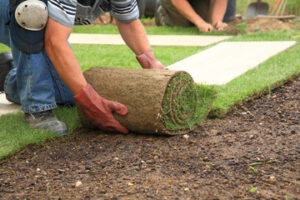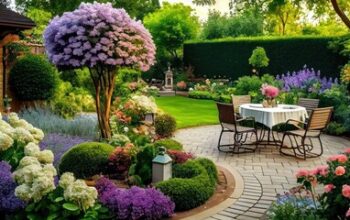Using resource efficient plants and materials can cut down on water use, fertilizers and pesticides. Choosing plant species that are adapted to your climate will also reduce maintenance.
Landscaping is more than gardening; it combines natural elements like trees, lawns and flowers with constructed features like walkways, water features and garden ornaments. Emphasizing lines in your design can create focal points and guide the eye through your landscape. Visit https://www.landscaping-greensboro.com/ to learn more.
A key element of landscaping is providing water to plants so they can thrive. This is accomplished through irrigation systems that distribute water to plants and soil. The type and frequency of watering depends on climate, soil conditions, plant species, and maintenance requirements.
An irrigation system includes a controller, a series of valves and stations, and the pipes that connect these elements together. The controller is programmed to operate a set schedule for each station or “zone.” A typical garden has several zones, such as lawn, shrub, and flower beds. The valves in a system open and close to deliver water to these zones at the appropriate times throughout the day.
Using an automated system to provide watering can help reduce manual labor and eliminate the need for a person to stand in a yard for long periods of time. It also ensures that each area is receiving the proper amount of water. A landscaper can install a smart irrigation controller that takes weather data into account to create a watering schedule that better matches the actual needs of the plants.
Irrigation is vital to any type of outdoor planting, from gardens and flowers to sports fields and golf courses. The right kind and amount of water can influence the entire growth process, from seedbed preparation to germination and root development to yield and quality. An irrigated crop can better utilize water by reducing runoff and surface evaporation, while minimizing weed growth and waste.
In addition to enhancing the aesthetic of an outdoor space, a well-maintained yard can increase the value of a home. In fact, studies have shown that homes with well-kept landscapes sell for more than those without a yard or yards that need work.
Landscaping can be done with both hardscapes and softscapes, depending on the preferences of a homeowner or property owner. While softscapes are more natural, such as grass and trees, hardscapes include features like retaining walls and outdoor structures that use materials such as stone or concrete. Landscaping can also include more large-scale design elements, such as water features and rock gardens.
Lighting
Landscape lighting is an important safety and security feature for your property. It also adds an aesthetic value to your home, which is why it is one of the few projects that consumers give a 10 Joy Score for. Hinkley offers a variety of LED landscape lighting kits, with everything you need to get started.
A successful landscape design features multiple focal points to draw the eye throughout the space. This is particularly true in areas of the landscape that are more house-centered than plant-centered. For example, a fountain or water feature can draw the eye from the entryway of your property and lead it around the house.
Water Features
Water features are stunning and beautiful additions to any landscape. From small-space bubblers to large ponds and waterfalls, they can be the perfect accent to your backyard retreat. They can also be a relaxing spot for entertaining guests and enjoying the beauty of nature. However, it’s important to find the right design that will fit in with the rest of your landscape. That’s where the expertise of a landscaping professional comes in handy. They’ll be able to help you bounce your landscape water feature ideas off of them and bring your vision to life.
The sound of flowing water is soothing and calming. It can even mask unwanted noises, making it the ideal backdrop for relaxation. It’s no wonder that water features are such a common sight in spas and resorts! Incorporate your own water element into your garden or patio, and you’ll instantly transform it into a tranquil oasis.
Whether it’s a simple fountain, a garden stream, or a pond with cascading waterfalls, you can customize the feature to suit your taste. You can add elements like driftwood and shells for a rustic look, or fire glass for a more modern aesthetic. You can even create a water curtain that adds a mesmerizing visual effect as it cascades down the surface of your garden.
Beyond their aesthetic appeal, many water features serve other purposes, such as providing a natural habitat for wildlife and helping to increase your property’s value. They also can improve air quality by releasing negative ions that attract dust and allergens, making them a natural humidifier.
A water feature can serve as the focal point of your landscape, transforming it into an oasis that you can enjoy with friends and family or by yourself. To get the most out of your water feature, be sure to keep it well-maintained by cleaning it regularly and adding in nutrients and oxygen that will prevent algae growth. For a truly unique feature, try incorporating a rock waterfall that is designed to mimic the flowing nature of the surrounding environment. It can be complemented with plants that thrive in moist environments, such as tropical flowers or ferns.
Maintenance
A well-maintained commercial landscape reflects positively on your business, boosting curb appeal and creating a welcoming environment for employees and visitors. However, landscaping is not a one-time event – it requires regular care and upkeep to keep your outdoor spaces healthy, vibrant, and functional.
Understanding the soil, plants, and climate of your property is critical to creating an effective seasonal maintenance plan. For example, knowing the type of soil you have can influence your watering schedule (for instance, sandy soil might need to be watered more frequently than clay soil), and understanding the life cycle of your plants can help you determine when they should be pruned or fertilized. Finally, knowing your geographical location and its climate can affect pests, diseases, and weather patterns.
Keeping your commercial landscape healthy, attractive, and functional starts with the right lawn care services. The nine essential services for any commercial landscape include:
Weekly or bi-weekly mowing, adjusted according to the growing season and growth rate. Edging and trimming, including trimming of the edges of driveways and walkways for a polished appearance. Weed prevention and control, using pre-emergent and post-emergent herbicides as needed. Soil testing and analysis to determine the correct types and amounts of fertilizers for your property.
Winter preparation, including draining gasoline from power equipment and applying fuel stabilizer for storage. Salting and ice control to reduce the risk of slippery surfaces. Regular cleaning and sanitizing of hydrants and spray equipment. Proper disposal of used chemicals in accordance with local and state regulations.

